Knowledge Center
June 18, 2024
Managing a Water Crisis in Sterile Processing
What to do when there's a boil alert – or something worse
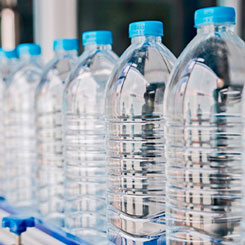
Sterile processing professionals are tasked with managing hundreds of instruments daily, staff shortages, and so much more. Policies and procedures are often in place for common occurrences, such as a failed quality test, but one thing a department manager may not be prepared for is receiving the message "there's no water."
Device processing must be halted in a water crisis, such as a boil alert or lack of water. This ultimately impacts procedure schedules and creates a backlog as devices can't be washed or sterilized using established methods. Just as with other potential problems, hospitals, especially sterile processing departments, should have an emergency water supply plan (EWSP) to address these issues if they arise1.
What is a Water Crisis in Sterile Processing?
Common Water Crisis Events:
- Boil Alerts – the water may have germs or other contaminants
- No Water – supply is temporarily disrupted
- Natural Disaster – expect long-term disruption
Potable water, often called tap water, comes to hospitals from a local municipality or a facility-owned well. Both sources must meet Environment Protection Agency (EPA) regulations. A water crisis occurs when water from these sources has been deemed contaminated or a disaster causes a physical disruption in the water supply.
While natural disasters like hurricanes may be the first type of water crisis that comes to mind, even areas not prone to natural disasters can encounter issues. Water pipes can break, treatment facilities can fail, and flooding or chemical spills can contaminate water sources.
Impacted Areas of Device Processing During a Water Crisis

Water is a critical component of sterile processing, with national standards and guidelines specifying the water quality needed for various functions. Most recently, ANSI/AAMI ST108 Water for the processing of medical devices was published, defining the quality required for each step of medical device processing and highlighting the importance of water to the overall success of the process.
Instruments exposed to potentially contaminated water may be subject to increased levels of microbial bioburden1, and because of this, all areas of processing are affected during a water crisis, including:
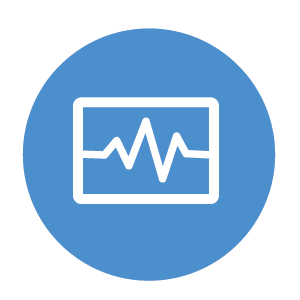
Point of Use Treatment – Water is often mixed with chemistry in the procedure room to initiate cleaning and keep devices moist during transport. Products like PRE-KLENZ™ Point of Use Processing Gel require no water and are proven to prohibit drying of soils on instruments for up to 72 hours.
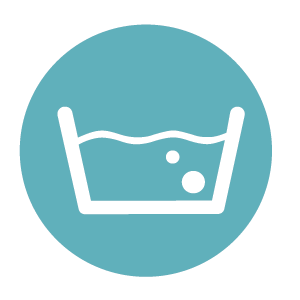
Manual Cleaning – Sinks use a large volume of water to soak, scrub, and clean visible soils from instruments. While some may argue that devices are already contaminated during this process, you do not want to add additional contaminants from poor water quality. Some manual cleaning processes also require a final rinse using critical water, achieved by removing a certain level of contaminants.
Washer/Disinfectors & Ultrasonic Cleaners – These automated washers require gallons of water to function properly and a certain level of water quality for effective chemistry performance. They may require critical water for a final rinse. Critical water is extensively treated to remove microorganisms and inorganic/organic materials to achieve the water quality measurement values outlined in ST108.
High-Level Disinfection – Much like washer/disinfectors, Automated Endoscope Reprocessors require a certain quality of water to properly clean and high-level disinfect devices.
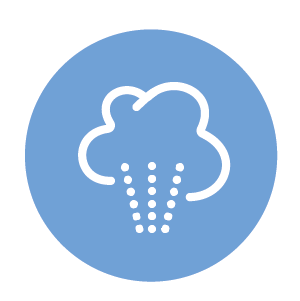
Steam Sterilization – An autoclave uses steam generated from facility tap water, and steam quality is directly affected by the quality of facility potable tap water.
Beyond these critical device processing steps that require water, water is used at eyewash stations for hand hygiene and to clean department surfaces.
What To Do During a Water Crisis
An emergency water supply plan (EWSP) is essential during a temporary or long-term water crisis. The facility should develop this to align with CDC, EPA, and device processing standards from organizations like the Association of periOperative Registered Nurses (AORN) and the Association for the Advancement of Medical Instrumentation (AAMI).
Recommended Immediate Steps in a Water Crisis:
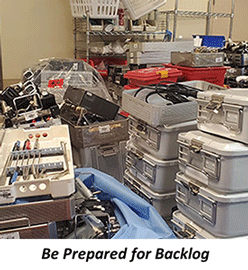
- Gather sterile processing (SPD), operating room (OR), and other procedural directors together to align on a plan
- Gather a count of all available sterile instrument sets
Note that any instrument sets that were processed with potentially contaminated water are considered contaminated and must be removed from inventory, both in sterile storage and assembly areas
- Ensure critical instrument sets are allotted for unplanned emergency surgeries
- Match the remaining devices to the needs of the schedule during the expected outage period
- Align with procedure schedulers to adjust and communicate changes to the schedule
- Plan to adjust staff schedules so that when water fully returns, any backlog of devices and can processed in a timely manner
This may be all that is needed for short-term water interruptions, as normal water operations may return in a matter of hours. However, when longer disruptions occur, additional questions should be posed and answered to determine the following steps:
- How long will the disruption last?
- What should be done with soiled instruments during a longer stoppage?
- Be prepared with pre-treatment products like PRE-KLENZ Point of Use Processing Gel, proven to keep soils moist for up to 72 hours.
- What processes can continue with bottled or boiled water?
- Can the facility supply boiled water? If yes, how much?
- Where can water be sourced (tankers, private wells, mobile water purification systems, etc.)?
- Can we outsource reprocessing to another facility in our network?
- Should we use an offsite reprocessing facility?
- Do we need to arrange a mobile processing center for long-term on-site processing?
- What alternative processes can we use to process devices?
How Can I Sterilize a Device With No Water?

Suppose water will be out for an extended period, such as after a natural disaster. In that case, facilities may elect to truck water in so that basic operations such as hand washing and cleaning of devices can continue. Facilities can use table-top steam sterilizers with bottled water sources to sterilize a device without typical steam processes. The downside is that this equipment may not be readily available and can only process small volumes of devices.
In a long-term emergency, the solution might be a few feet away from your steam sterilizer. V-PRO™ Low Temperature Sterilization Systems can sterilize devices without water. The only utility requirement is an electrical supply – no plumbing, special ventilation, or air supply. This flexibility means you can use multiple V-PRO Sterilizers to quickly turn around a broad range of devices, as each V-PRO maX 2 Sterilizer can process up to 50lbs in 28 minutes or 11lbs as fast as 16 minutes.
Examples of Devices that can be Processed in V-PRO™ Sterilizers
- General Stainless Steel Instruments
- Laryngoscope Blades
- Cystoscopy
- Ureteroscopes
- Bronchoscopes
- Batteries
- Drills
- Telescopes
- daVinci® Endoscopes*
- Lumened and non-lumened rigid and flexible scopes
Visit the V-PRO Device Matrix to find out if your device can be reprocessed in a V-PRO Low Temperature Sterilization System. For specific claims, see the equipment Operator Manual.
Actions After a Mandated Boil Advisory or Water Shutdown
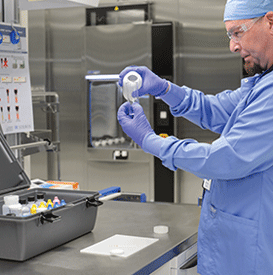
The Centers for Disease Control and Prevention (CDC) recommends that after a water emergency or stoppage, facilities should flush all equipment water lines following the manufacturer's instructions, drain/refill hot water heaters, and change all point-of-entry filters of equipment that uses water, such as automated endoscope reprocessors2.
Facility water treatment systems should also be flushed after a water emergency, or specific cycles run according to the manufacturer's instructions. Each facility should then monitor and test water quality, and meetings should be held with risk management and infection prevention departments.
If equipment in sterile processing is down for an extended period, it may need to be decontaminated before use. Departments should always refer to each equipment manufacturer for recommendations. Once the equipment is ready to resume operation, managers should review the instrument's needs with the surgical team to prioritize any instrument backlogs requiring immediate sterilization.
Being Prepared for a Water Crisis in Sterile Processing
A water emergency can cause a multitude of negative operational and financial consequences for healthcare providers. A thorough emergency preparedness plan to address water crises should be on hand, and both the EPA and the CDC offer information to help with this planning, including "Emergency Water Supply Planning Guide for Hospitals and Healthcare Facilities" from the CDC1.
If you are already prepared with a long and short-term plan, review your plans regularly to ensure that each department knows its role and has what it needs to execute the plan. This will ensure you are prepared to minimize the negative impact on the facility, staff, patients, and visitors.
Related Resources
*da Vinci is a registered trademark of Intuitive Surgical, Inc.
Article References
1 Centers for Disease Control and Prevention. (2020, February 18). Emergency Water Supply Planning Guide for Hospitals and Healthcare Facilities. Centers for Disease Control and Prevention. https://www.cdc.gov/healthywater/emergency/ewsp.html
2 Centers for Disease Control and Prevention. (2010, November 2). Hospitals, Health Care Facilities & Nursing Homes On this Page During a boil water advisory When a boil advisory is cancelled Related links General Procedures Drinking Water Cooking and Food Preparation Handwashing During a boil water advisory. Centers for Disease Control and Prevention. https://www.cdc.gov/




